The Effect of Housing System on Disease Prevalence and Productive Lifespan of Dairy Herds—A Case Study
Abstract
Simple Summary
Abstract
1. Introduction
2. Materials and Methods
- Free-stall barn with a slatted floor. The barn features pens where all cows can lie down at the same time. A cow pen is enclosed by metal bars, and it is a resting area that separates individual cows from the other animals in the barn. Each pen is laid with a rubber mat, and it is designed to hold one cow. The barn has a slatted floor which is scraped by robots.
- Free-stall barn with a self-cleaning floor. Animals have free access to pens with straw bedding. The barn has a solid floor which is cleaned automatically twice a day (before morning and evening milking).
- Open-pack barn with deep litter. Cows can choose warm and comfortable resting areas with deep litter bedding. Resting areas are not separated from manure areas, and they are supplemented with fresh and dry straw every day.
- Tie-stall barn. Each tie-stall features a resting area, a feeder, an automatic drinker and a tether that keeps cows inside individual stalls. Stalls are separated by rails. Each stall ends with an opening (with an estimated depth of 20 cm) where excrement is evacuated to the manure plate. Straw is replaced twice daily. In this system, cows are fed and milked individually. The floor is cleaned with a flap scraper. Cows have the possibility of exercising during milking (about 60 min), feeding (about 30 min), watering (about 60 min), manure removal (about 15 min every 2 h for 8 h) per day. Cow trainers were not used here.
3. Results
4. Discussion
5. Conclusions
Author Contributions
Funding
Institutional Review Board Statement
Informed Consent Statement
Data Availability Statement
Conflicts of Interest
References
- United States Department of Agriculture. Dairy Production and Trade Developments. Available online: https://apps.fas.usda.gov/psdonline/circulars/dairy.pdf (accessed on 13 May 2022).
- EUROSTAT. Key Figures on the European Food Chain. Luxembourg: Publications Office of the European Union. Available online: https://ec.europa.eu/eurostat/documents/3217494/13957877/KS-FK-21-001-EN-N.pdf/dcf8d423-fa1c-5544-0813-b8e5cde92b59?t=1639565437333 (accessed on 7 May 2022).
- OECD-FAO. Agricultural Outlook 2021–2030. Available online: https://www.oecd-ilibrary.org/agriculture-and-food/oecd-fao-agricultural-outlook-2021-2030_19428846-en (accessed on 6 May 2022).
- Jankowska, M.; Sawa, A.; Gierszewski, R. Effect of some factors on cow’s body condition and fertility. Rocz. Nauk. Pol. Tow. Zootech. 2012, 8, 9–16. [Google Scholar]
- Wardal, W.J. Factors determining the choice of a housing system for dairy cows. Probl. Inż. Roln. 2015, 4, 81–88. [Google Scholar]
- Hansen, M.N. Comparison of the labour requirement involved in the housing of dairy cows in different housing systems. Acta Agric. Scand. A Anim. Sci. 2000, 50, 153–160. [Google Scholar] [CrossRef]
- Boćkowski, M.; Gaworski, M. Assessment indices of barns with a varied maintenance system of dairy cows. Agric. Eng. 2013, 3, 31–39. [Google Scholar]
- Directive 2011/92/EU of the European Parliament and of the Council of 13 December 2011 on the Assessment of the Effects of Certain Public and Private Projects on the Environment Text with EEA Relevance OJ L 26, 28 January 2012, p. 1–21. Available online: https://eur-lex.europa.eu/legal-content/EN/TXT/?uri=celex%3A32011L0092 (accessed on 21 April 2022).
- Sawa, A.; Bogucki, M. Longevity of cows depending on their first lactation yield and herd production level. Ann. Anim. Sci. 2017, 17, 1171–1183. [Google Scholar] [CrossRef][Green Version]
- Popescu, S.; Borda, C.; Diugan, E.A.; Niculae, M.; Razvan, S.; Sandru, C.D. The effect of the housing system on the welfare quality of dairy cows. Ital. J. Anim. Sci. 2014, 13, 2940. [Google Scholar] [CrossRef]
- Beaver, A.; Weary, D.M.; Keyserlingk, A.G. Invited review: The welfare of dairy cattle housed in tiestalls compared to less-restrictive housing types: A systematic review. J. Dairy Sci. 2021, 104, 9383–9417. [Google Scholar] [CrossRef]
- Witkowska, D. Volatile gas concentrations in turkey houses estimated by Fourier Transform Infrared Spectroscopy (FTIR). Br. Poult. 2013, 54, 289–297. [Google Scholar] [CrossRef]
- Witkowska, D.; Korczyński, M.; Koziel, J.A.; Sowińska, J.; Chojnowski, B. The effect of dairy cattle housing systems on the concentrations and emissions of gaseous mixtures in barns determined by Fourier-transform infrared spectroscopy. Ann. Anim. Sci. 2020, 11, 1487–1507. [Google Scholar] [CrossRef]
- Cramer, G.; Lissemore, K.D.; Guard, C.L.; Leslie, K.E.; Kelton, D.F. Herd- and cow- level prevalence of foot lesions in Ontario dairy cattle. J. Dairy Sci. 2008, 91, 3888–3895. [Google Scholar] [CrossRef]
- Kuczaj, M.; Preś, J.; Kinal, S.; Nicpoń, J.; Łuczak, W.; Zielak-Steciwko, A. Some factors of dairy cows and calves husbandry, maintenance and feeding influencing their health status and welfare. Zesz. Nauk. UP Wroc. Biol. Hod. Zwierz. 2010, 61, 215–228. [Google Scholar]
- Pytlewski, J.; Antkowiak, I.; Staniek, M.; Skrzypek, R. Intensity and causes of culling in Polish Black-and-White Holstein-Friesian cows. Ann. Anim. Sci. 2010, 10, 477–487. [Google Scholar]
- Sheldon, I.M.; Cronin, J.G.; Bromfield, J.J. Tolerance and innate immunity shape the development of postpartum uterine disease and the impact of endometritis in dairy cattle. Annu. Rev. Anim. Biosci. 2018, 7, 361–384. [Google Scholar] [CrossRef] [PubMed]
- Clark, M.; Tilman, D. Comparative analysis of environmental impacts of agricultural production systems, agricultural input efficiency, and food choice. Environ. Res. Lett. 2017, 12, 064016. [Google Scholar] [CrossRef]
- Amory, J.R.; Barker, Z.E.; Wright, J.L.; Mason, S.A.; Blowey, R.W.; Green, L.E. LAMECOW at the University in Warwick: A study of lameness in dairy cows. Cattle Pract. 2006, 14, 123–125. [Google Scholar]
- Willshire, J.A.; Bell, N.J. An economic review on cattle lameness. Cattle Pract. 2009, 17, 136–141. [Google Scholar]
- Capion, N.; Thamsborg, S.M.; Enevoldsen, C. Conformation of hind legs and lameness in Danish Holstein heifers. J. Dairy Sci. 2008, 91, 2089–2097. [Google Scholar] [CrossRef]
- Praks, J.; Poikalainen, V.; Vermäe, I.; Sossidou, E. Livestock production systems: Welfare, environment and product quality. Cattle. In Farm Animal Welfare, Environment & Food Quality Interaction Studies; Sossidou, E., Szücs, E., Eds.; National Agricultural Research Foundation: Giannitsa, Greece, 2007; pp. 201–233. [Google Scholar]
- Cozzi, G.; Brscic, M.; Gottardo, F. Animal welfare as a pillar of a sustainable farm animal production. Acta Agric. Slov. 2008, 2, 23–31. [Google Scholar]
- Tse, C.; Barkema, H.W.; DeVries, T.J.; Rushen, J.; Pajor, E.A. Effect of transitioning to automatic milking systems on producers’ perceptions of farm management and cow health in the Canadian dairy industry. J. Dairy Sci. 2017, 100, 2404–2414. [Google Scholar] [CrossRef]
- Krpálková, L.; Cabrera, V.E.; Zavadilová, L.; Štípková, M. The importance of hoof health in dairy production. Czech J. Anim. Sci. 2019, 64, 107–117. [Google Scholar] [CrossRef]
- Dirksen, G.; Grunder, H.; Stober, M. Bovine Internal Diseases and Surgery, 5th ed.; Galaktyka: Łódź, Poland, 2009; pp. 1029–1101. [Google Scholar]
- Huijps, K.; Hogeveen, H.; Lam, T.J.G.M.; Oude Lansink, A.G.J.M. Costs and efficacy of management measures to improve udder health on Dutch dairy farms. J. Dairy Sci. 2010, 93, 115–124. [Google Scholar] [CrossRef] [PubMed]
- Hogeveen, H.; Huijps, K.; Lam, T.J.G.M. Economic aspects of mastitis: New developments. N. Z. Vet. J. 2011, 59, 16–23. [Google Scholar] [CrossRef] [PubMed]
- Leslie, K.E.; Petersson-Wolfe, C.S. Assessment and management of pain in dairy cows with clinical mastitis. Vet. Clin. N. Am. Food Anim. Pract. 2012, 28, 289–305. [Google Scholar] [CrossRef] [PubMed]
- Silva, S.R.; Araujo, J.P.; Guedes, C.; Silva, F.; Almeida, M.; Cerqueira, J.L. Precision technologies to address dairy cattle welfare: Focus on lameness, mastitis and body condition. Animals 2021, 11, 2253. [Google Scholar] [CrossRef]
- Sowińska, J.; Witkowska, D.; Bursztynowicz, K.; Kwiatkowska-Stenzel, A.; Mituniewicz, T.; Wójcik, A. Relationship between environmental conditions and physiological indicators of horses’ welfare. Med. Weter. 2015, 71, 486–492. [Google Scholar]
- Mee, F.; Boyle, L.A. Assessing whether dairy cow welfare is “better” in pasture-based than in confinement-based management systems. N. Z. Vet. J. 2020, 68, 168–177. [Google Scholar] [CrossRef]
- Somers, J.G.C.J.; Frankena, K.; Noordhuizen-Stassen, E.N.; Metz, J.H.M. Prevalence of claw disorders in Dutch dairy cows exposed to several floor systems. J. Dairy Sci. 2003, 86, 2082–2093. [Google Scholar] [CrossRef]
- Olmos, G.; Boyle, L.; Hanlon, A.; Patton, J.; Murphy, J.J.; Mee, J.F. Hoof disorders, locomotion ability and lying times of cubicle-housed compared to pasture-based dairy cows. Livest. Sci. 2009, 125, 199–207. [Google Scholar] [CrossRef]
- Borshch, O.O.; Borshch, O.V.; Kosior, L.T.; Pirova, L.V.; Lastovska, I.O. Influence of various litter materials and premises characteristics on the comfort and behavior of cows. Ukr. J. Ecol. 2017, 7, 529–535. [Google Scholar] [CrossRef]
- Napolitano, F.; Knierim, U.; Grasso, F.; De Rosa, G. Positive indicators of cattle welfare and their applicability to on-farm protocols. Ital. J. Anim. Sci. 2009, 8, 355–365. [Google Scholar] [CrossRef]
- Novotna, I.; Langova, L.; Havlicek, Z. Risk factors and detection of lameness using infrared thermography in dairy cows—A review. Ann. Anim. Sci. 2019, 19, 563–578. [Google Scholar] [CrossRef]
- Sawa, A.; Bogucki, M.; Neja, W. Dry period length and performance of cows in the subsequent production cycle. Arch. Tierz. 2012, 55, 140–147. [Google Scholar] [CrossRef]
- Skarżyńska, A. The impact of the milk yield of cows on the profitability of milk production. Probl. Agric. Econ. 2012, 330, 90–111. [Google Scholar]
- Sobek, Z.; Dymarski, I.; Piekarska, O. The analysis of a longevity and the reasons of milking cow’s cull from the herd ZZD IZ Pawlowice. Acta Sci. Pol. Zootech. 2005, 4, 97–112. [Google Scholar]
- Loberg, J.; Telezhenko, E.; Bergsten, C.; Lidfors, L. Behaviour and claw health in tied dairy cows with varying access to exercise in an outdoor paddock. Appl. Anim. Behav. 2004, 89, 1–16. [Google Scholar] [CrossRef]
- Keil, N.M.; Wiederkehr, T.U.; Friedli, K.; Wechsler, B. Effects of frequency and duration of outdoor exercise on the prevalence of hock lesions in tied Swiss dairy cows. Prev. Vet. Med. 2006, 74, 142–153. [Google Scholar] [CrossRef]
- Corsar, M. Investigation of hind limb lameness in cattle not involving the foot. Cattle Pract. 2007, 15, 262. [Google Scholar]
- Vasilev, N.; Dinev, D.; Mitev, J.; Koleva, M.; Miteva, T. Hygiene status of dairy cows reared in a spacious building and resulting quality of produced milk. Trakia J. Sci. 2007, 5, 47–51. [Google Scholar]
- Ruud, L.E.; Bøe, K.E.; Østerås, O. Risk factors for dirty dairy cows in Norwegian free stall systems Author links open overlay panel. J. Dairy Sci. 2010, 93, 5216–5224. [Google Scholar] [CrossRef]
- Mordak, R. Lameness in cows—The multifactorial health problem. Życie Weter. 2008, 4, 288–291. [Google Scholar]
- Pezzanite, L.; Neary, M.; Hutchens, T. Footrot in Sheep and Goats. Available online: https://www.extension.purdue.edu/extmedia/As/As-596-footrot.pdf (accessed on 16 March 2022).
- Sławuta, P.; Nicpoń, J.; Mróz, K.; Nicpoń, J. Etiopathogenesis, diagnosis and therapy of selected non-traumatic digitis diseases in cattle. Med. Weter. 2005, 61, 1221–1224. [Google Scholar]
- Bell, N.J. Lameness: Evaluation, hazards and interventions. Cattle Pract. 2005, 13, 103–112. [Google Scholar]
- Pilatti, J.A.; Vieira, F.M.C. Environment, behavior and welfare aspects of dairy cows reared in compost bedded pack barns system. Anim. Behav. Biometeorol. 2017, 5, 97–105. [Google Scholar] [CrossRef]
- Grove-White, D. Healthcare in the modern dairy herd. Practice 2004, 26, 368–376. [Google Scholar] [CrossRef]
- Telezhenko, E.; Bergsten, C. Influence of floor type on the locomotion of dairy cows. Appl. Anim. Behav. 2005, 93, 183–197. [Google Scholar] [CrossRef]
- Kibar, M.; Çağlayan, T. Effect of Hoof Trimming on Milk Yield in Dairy Cows with Foot Disease. Acta Sci. Vet. 2018, 44, 7. [Google Scholar] [CrossRef][Green Version]
- Laven, R.A. The relationship between hoof conformation and digital dermatitis in dairy cattle. Cattle Pract. 2007, 15, 93–95. [Google Scholar]
- Hinterhofer, C.; Haider, H.; Apprich, V.; Ferguson, J.C.; Collins, S.N.; Stanek, C. Development of a twenty-one-component finite element distal hind limb model: Stress and strain in bovine digit structures as a result of loading on different floorings. J. Dairy Sci. 2009, 92, 972–979. [Google Scholar] [CrossRef]
- Kofler, J.; Pesenhofer, R.; Landl, G.; Sommerfeld-Stur, I.; Peham, C. Langzeitkontrolle der Klauengesundheit von Milch-kühen in 15 Herden mithilfe des Klauenmanagers und digitaler Kennzahlen. Tierärztl. Prax. 2013, 41, 31–44. [Google Scholar]
- Manske, T.; Hultgren, J.; Bergsten, C. Prevalence and relationships of hoof lesions and lameness in Swedish dairy cows. J. Dairy Sci. 2002, 54, 247–263. [Google Scholar]
- Enevoldsen, C. Prevalence and hoof lesions in Danish Holstein cows. Vet. Rec. 2008, 163, 80–86. [Google Scholar]
- EFSA. Scientific opinion on welfare of dairy cows in relation to udder problems based on a risk assessment with special reference to the impact of housing, feeding, management and genetic selection. EFSA J. 2009, 1141, 1–60. [Google Scholar]
- Siivonen, J.; Taponen, S.; Hovinen, M.; Pastell, M.; Lensink, B.J.; Pyörälä, S.; Hänninen, L. Impact of acute clinical mastitis on cow behaviour. Appl. Anim. Behav. 2011, 132, 101–106. [Google Scholar] [CrossRef]
- Houe, H.; Østergaard, S.; Thilsing-Hansen, T.; Jørgensen, R.J.; Larsen, T.; Sørensen, J.T.; Agger, J.F.; Blom, J.Y. Milk fever and subclinical hypocalcemia—An evaluation of parameters on incidence risk, diagnosis, risk factors and biological effects as input for a decision support system for disease control. Acta Vet. Scand. 2001, 42, 1–29. [Google Scholar]
- Wang, C. Influence of Dietary Factors on Calcium Metabolism and Incidence of Parturient Paresis in Dairy Cows. Ph.D. Thesis, University of Florida, Gainesville, FL, USA, 1990. [Google Scholar]
- Webster, A.J.T.; Knott, L.; Tarlton, J.F. Understanding lameness in the dairy cow. Cattle Pract. 2005, 13, 93–98. [Google Scholar]
- Motamedi, N.; Mohamadnia, A.; Khoramian, B.; Azizzadeh, M. Evaluation of mastitis impact on lameness and digital lesions in dairy cows. Iran. J. Vet. Surg. 2018, 1, 39–46. [Google Scholar]
- Zhang, X.; Ding, J.; Li, Y.; Song, O.; Li, S.; Abid Hayat, M.; Zhang, J.; Wang, H. The changes of inflammatory mediators and vasoactive substances in dairy cows’ plasma with pasture-associated laminitis. BMC Vet. Res. 2020, 16, 119. [Google Scholar] [CrossRef]
- Capion, N.; Thamsborg, S.M.; Chen, J.M.; Stull, C.L.; Ledgerwood, D.N.; Tucker, C.B. Muddy conditions reduce hygiene and lying time in dairy cattle and increase time spent on concrete. J. Dairy Sci. 2017, 100, 2090–2103. [Google Scholar]
- Kwiatkowska-Stenzel, A.; Sowińska, J.; Witkowska, D. Analysis of noxious gas pollution in horse stable air. J. Equine Vet. Sci. 2014, 34, 249–256. [Google Scholar] [CrossRef]
- Kwiatkowska-Stenzel, A.; Sowińska, J.; Witkowska, D. The effect of different bedding materials used in stable on horses behavior. J. Equine Vet. Sci. 2016, 42, 57–66. [Google Scholar] [CrossRef]
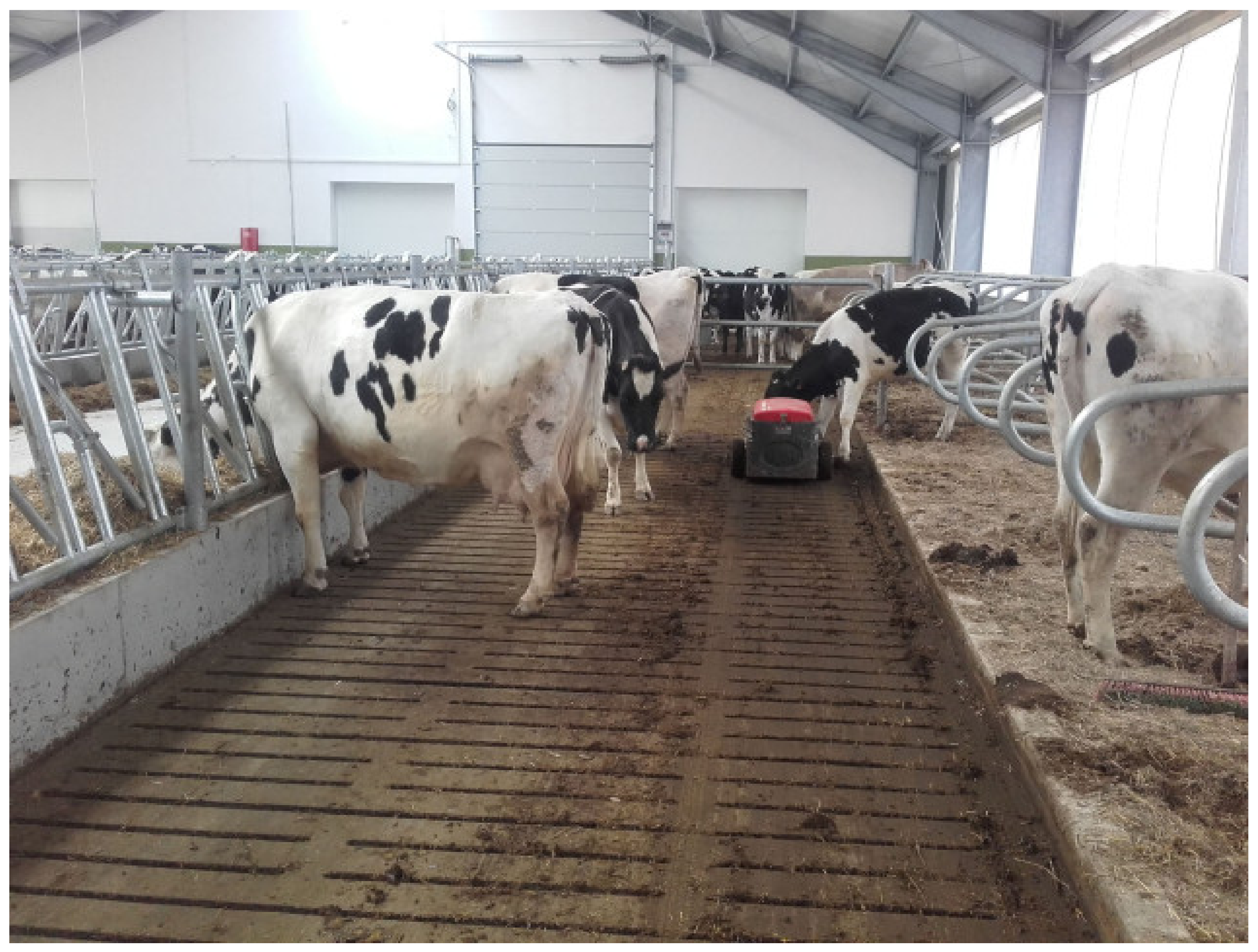
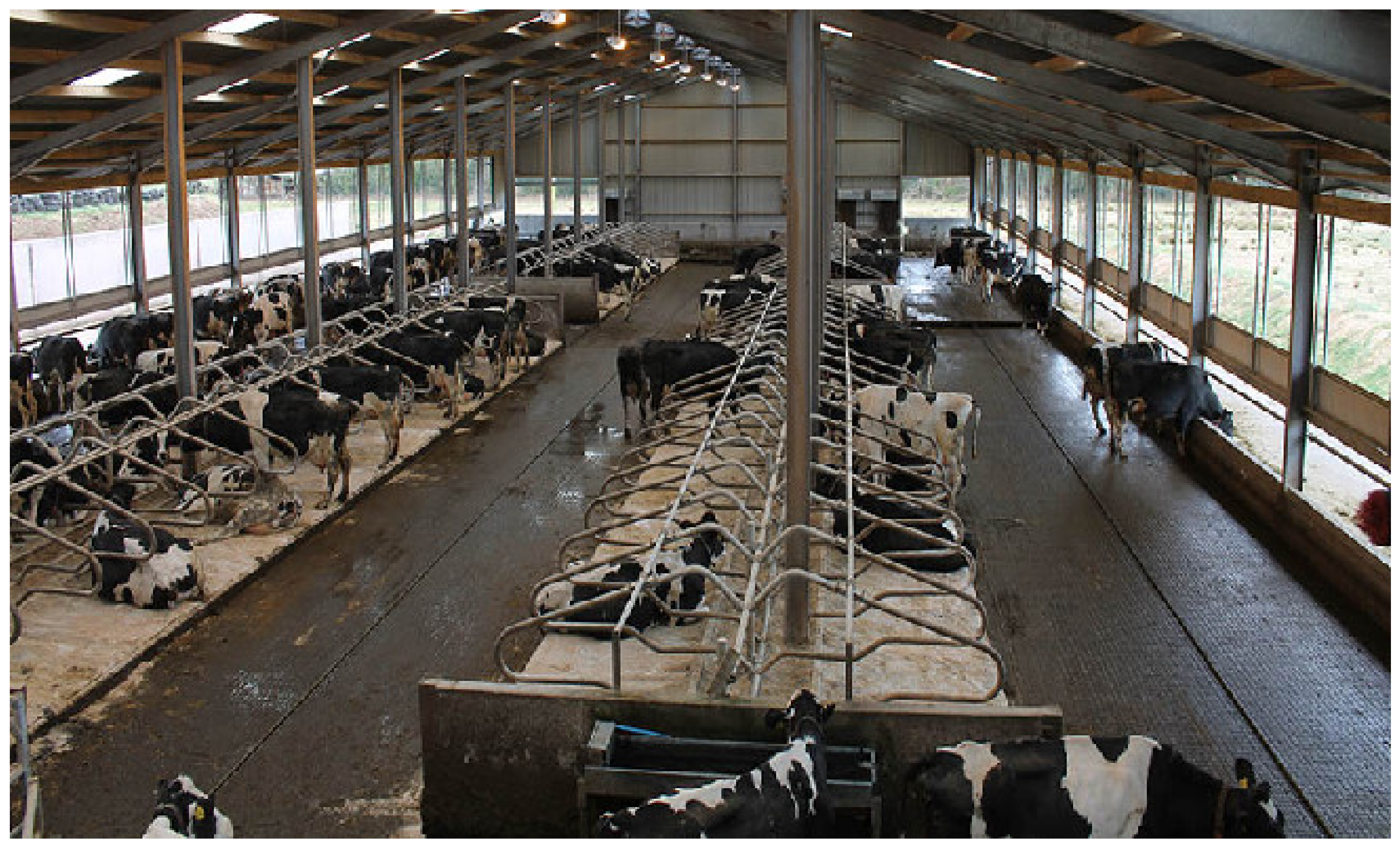


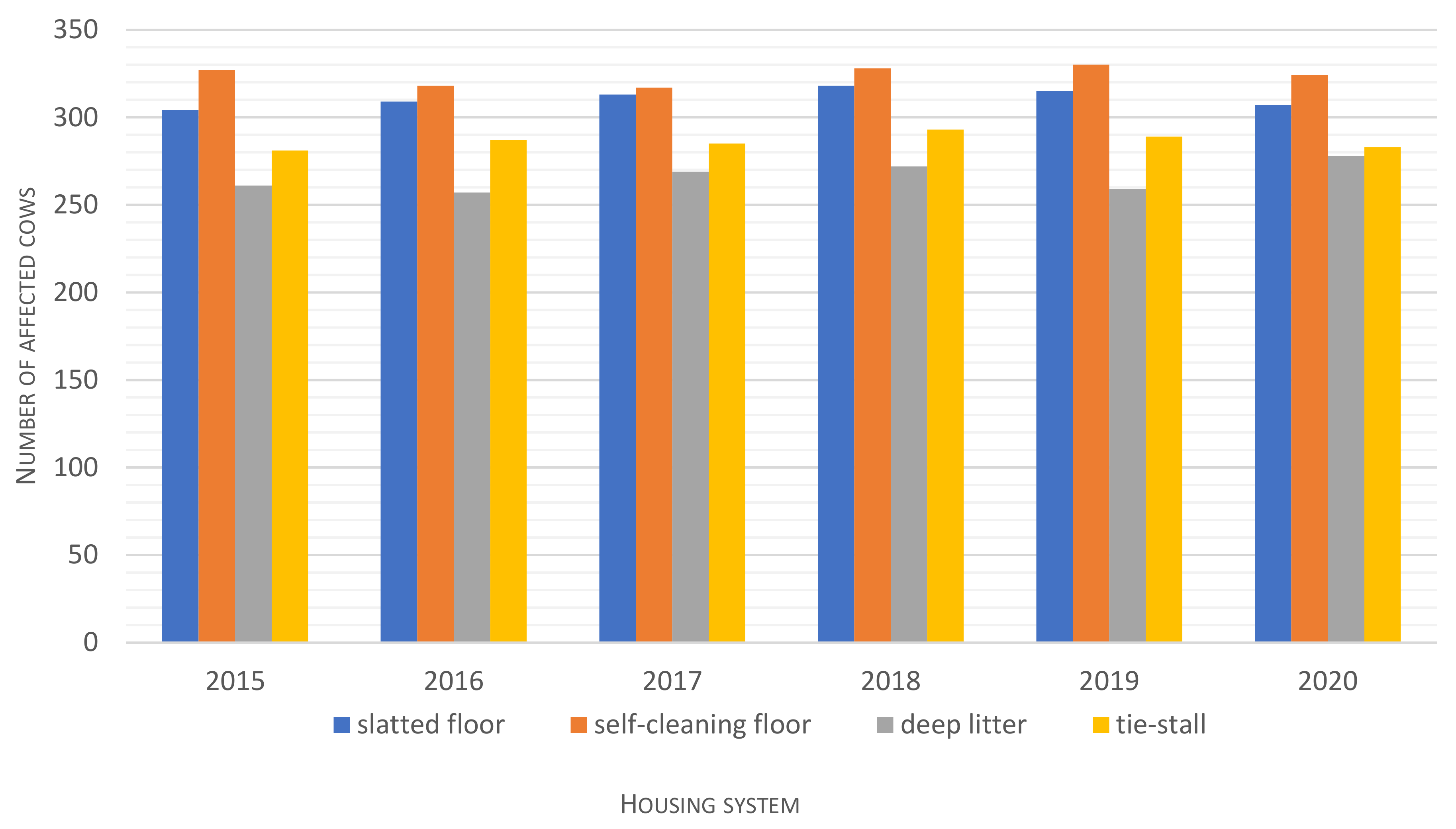
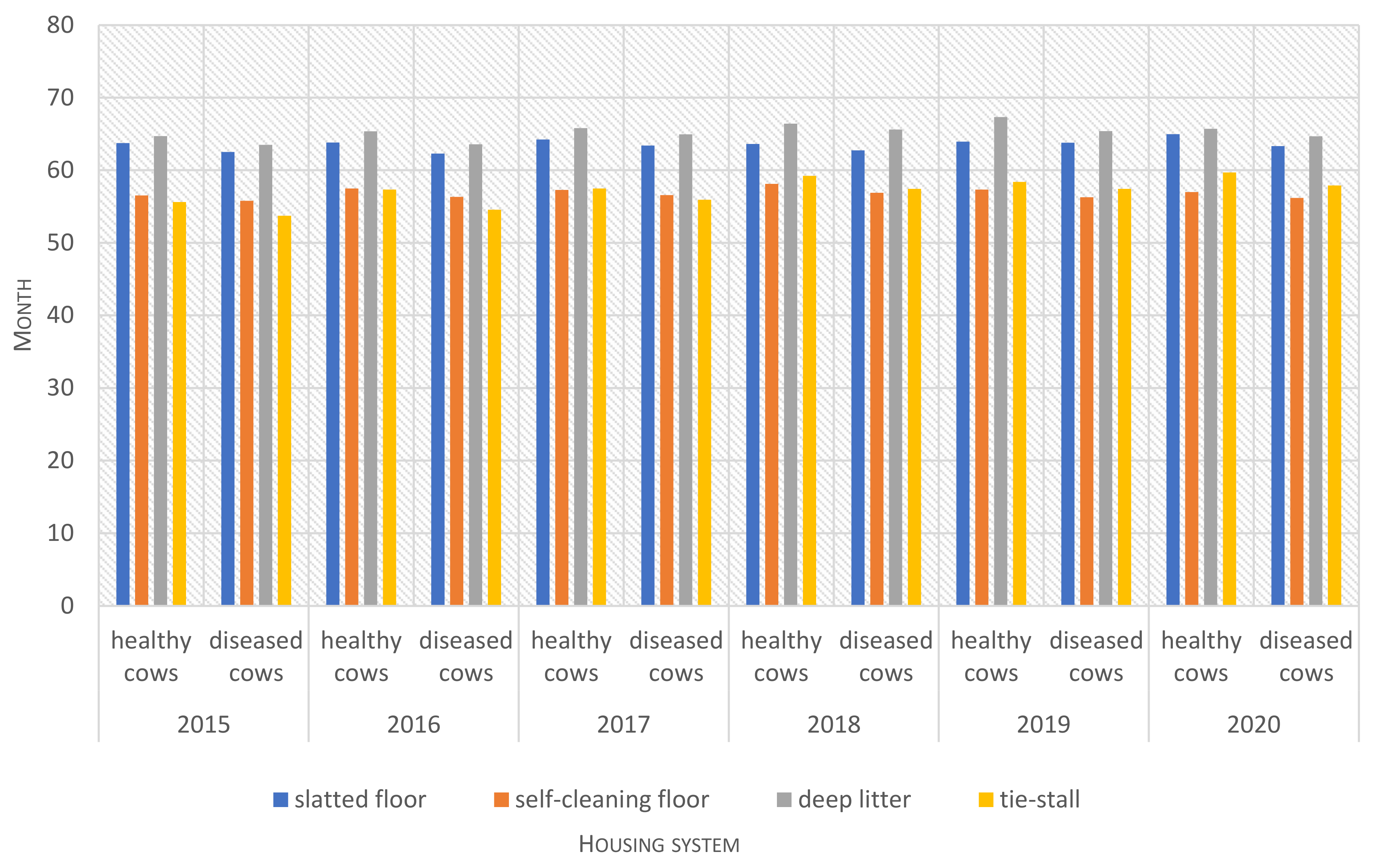
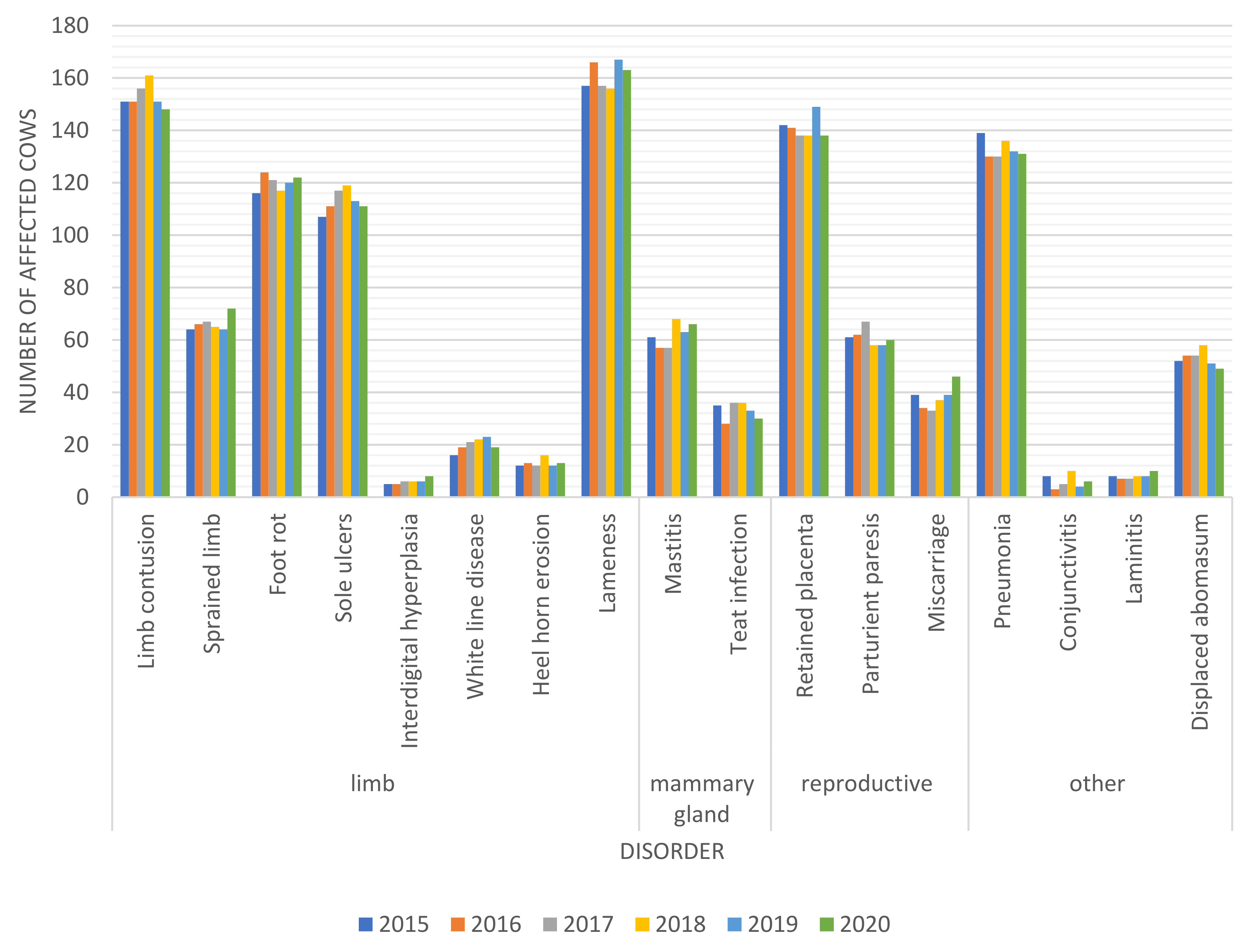
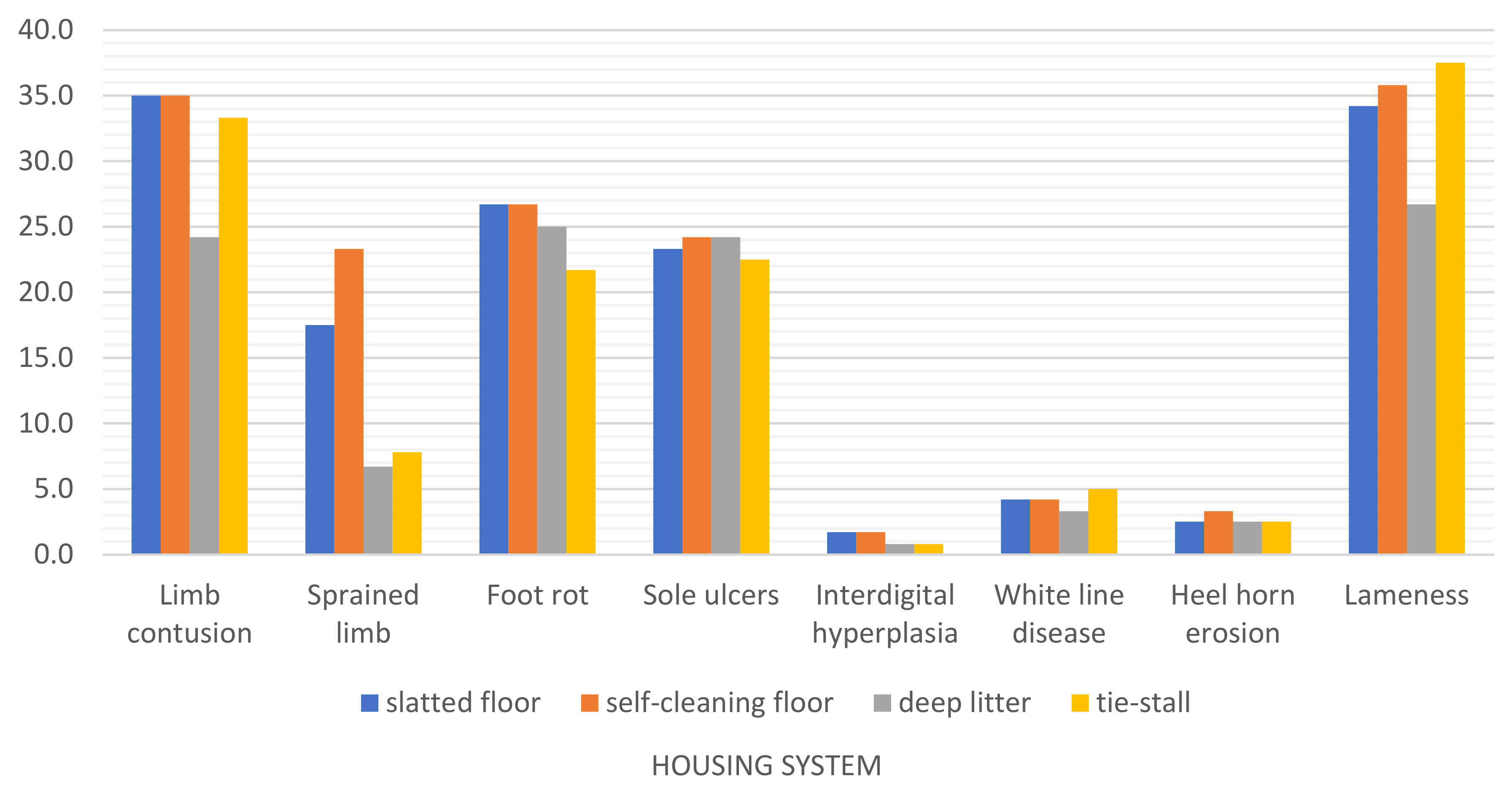
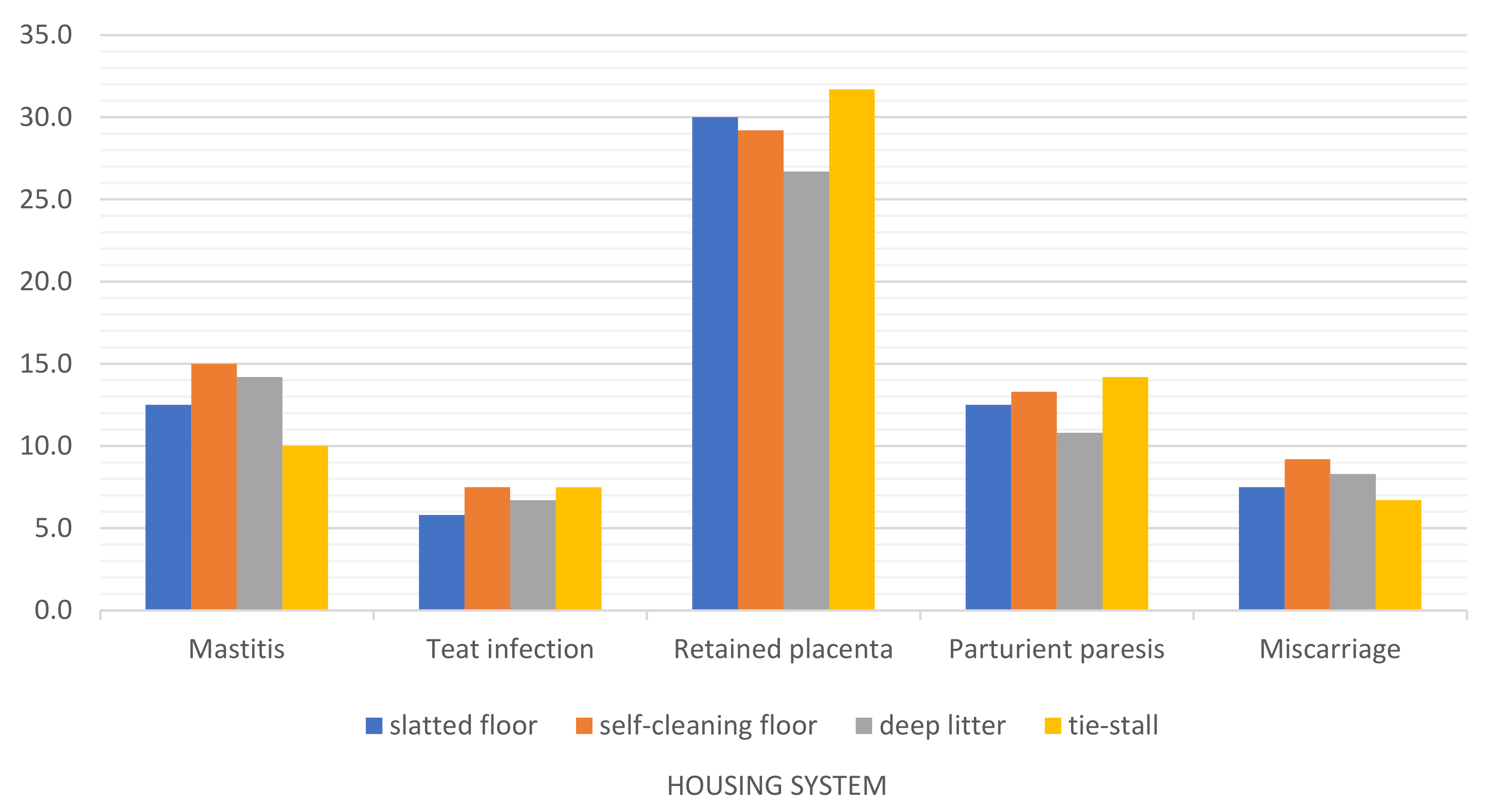
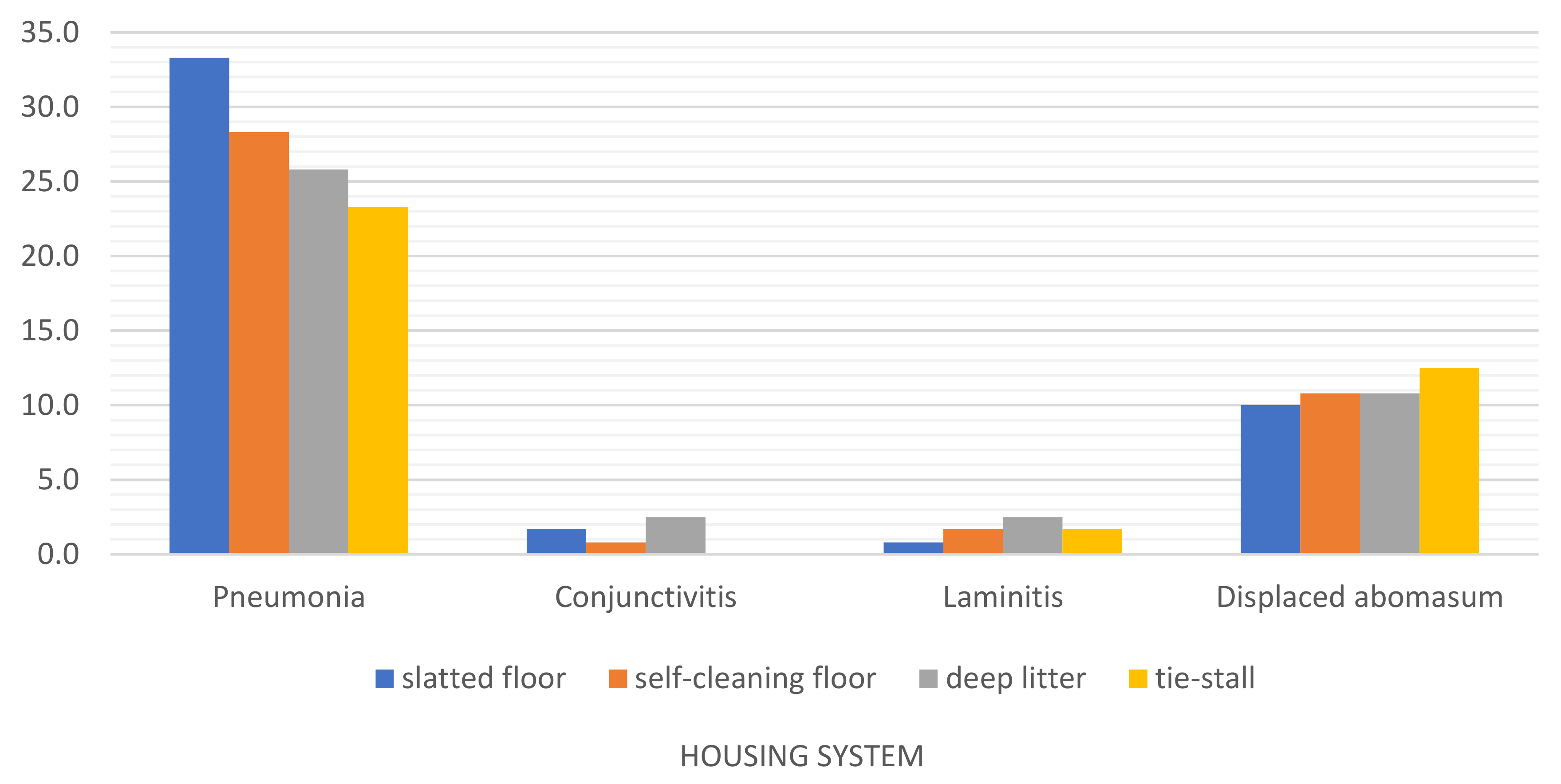
| Free-Stall Systems | Tie-Stall System | |||
|---|---|---|---|---|
| Slatted Floor | Self-Cleaning Floor | Deep Litter | ||
| Herd size (head) | 120 | 120 | 120 | 120 |
| Floor type | Slatted | Solid | Straw | Solid concrete |
| Bedding | Rubber mat with a thickness of 6 cm | Straw | Straw | Straw |
| Manure removal | Manure is removed by robots every 240 min | Manure is scraped twice a day before each milking | Fresh straw is supplied each day; manure is removed four times a year | Manure is removed twice a day with a flap scraper before every milking |
| Ventilation | Natural ventilation | Natural ventilation | Mechanical ventilation | Natural and mechanical ventilation |
| Milking system | Parallel milking parlor | Fishbone milking parlor | Fishbone milking parlor | Pipeline milking machine |
| Hoof care | Foot bath: formalin and copper sulfate, twice a month | Foot bath: formalin and copper sulfate, twice a month | Foot bath: formalin and copper sulfate, twice a month | Manual sprayer: formalin and copper sulfate, twice a month |
| Hoof trimming | Twice a year and if required | Twice a year and if required | Twice a year and if required | If required |
| Feed pushing | Feed pusher robot | Feed pusher robot | Feed pusher robot | Feed pusher robot |
| Feed pushing frequency | At intervals of 180 min | At intervals of 210 min | At intervals of 180 min | At intervals of 210 min |
| Feed | PMR+ feeding station | PMR+ feeding station | PMR+ feeding station | TMR |
| Control of estrus and feed intake | 24 h electronic monitoring system | 24 h electronic monitoring system | 24 h electronic monitoring system | Observation |
| Parameter | Total | Housing System | p-Value | |||
|---|---|---|---|---|---|---|
| Slatted Floor | Self-Cleaning Floor | Deep Litter | Tie-Stall | |||
| Overall morbidity | 7124 | 1866 | 1944 | 1596 | 1718 | - |
| Average morbidity | 296.83 ± 4.80 257.00–330.00 | 311.02 B ± 2.14 304.00–318.00 | 324.14 A ± 2.20 317.00–330.00 | 266.00 D ± 3.37 257.00–278.00 | 286.33 C ± 1.76 281.00–293.00 | 0.000177 |
| Average productive lifespan of the entire population | 60.66 ± 0.57 53.72–67.32 | 63.53 B ± 0.22 62.28–64.97 | 56.81 C ± 0.19 55.78–58.11 | 65.25 A ± 0.31 63.50–67.32 | 57.06 C ± 0.52 53.72–59.68 | 0.000169 |
| Average productive lifespan of healthy cows | 61.29 ± 0.79 55.62–67.32 | 64.05 B ± 0.20 63.61–64.97 | 57.28 C ± 0.22 56.51–58.11 | 65.88 A,B ± 0.37 64.68–67.32 | 57.95 C ± 0.60 55.62–59.68 | 0.000175 |
| Average productive lifespan of diseased cows | 60.03 ± 0.82 53.72–65.61 | 63.00 A ± 0.24 62.28–63.78 | 56.34 B ± 0.15 55.78–56.89 | 64.61 A ± 0.37 63.50–65.61 | 56.17 B ± 0.70 53.72–57.89 | 0.000175 |
| Disorders | Total | Mean | SEM | % | |
|---|---|---|---|---|---|
| Limb | Limb contusion | 918 | 38.25 | 0.12 | 31.88 |
| Sprained limb | 398 | 16.58 | 0.18 | 13.82 | |
| Footrot | 720 | 30.00 | 0.06 | 25.00 | |
| Sole ulcers | 678 | 28.25 | 0.03 | 23.54 | |
| Interdigital hyperplasia | 36 | 1.50 | 0.01 | 1.25 | |
| White line disease | 120 | 5.00 | 0.02 | 4.17 | |
| Heel horn erosion | 78 | 3.25 | 0.02 | 2.71 | |
| Lameness | 966 | 40.25 | 0.11 | 33.54 | |
| Mammary gland | Mastitis | 372 | 15.50 | 0.06 | 12.92 |
| Teat infection | 198 | 8.25 | 0.03 | 6.88 | |
| Reproductive | Retained placenta | 846 | 35.25 | 0.06 | 29.38 |
| Parturient paresis | 336 | 15.25 | 0.04 | 12.71 | |
| Miscarriage | 228 | 9.50 | 0.04 | 7.92 | |
| Remaining | Pneumonia | 798 | 33.25 | 0.10 | 27.71 |
| Conjunctivitis | 36 | 1.50 | 0.02 | 1.25 | |
| Laminitis | 48 | 2.00 | 0.02 | 1.67 | |
| Displaced abomasum | 318 | 13.25 | 0.03 | 11.04 | |
| Total | 7124 | 17.46 | 0.04 | 14.55 | |
| Disorder or Symptom | Housing System | p-Value | Total | |||
|---|---|---|---|---|---|---|
| Slatted Floor | Self-Cleaning Floor | Deep Litter | Tie-Stall | |||
| Limb contusion | 42.00 A ± 1.09 | 42.00 A ± 0.57 | 29.00 B ± 0.57 | 40.00 A ± 0.63 | ≤0.00001 | 38.25 ± 1.17 |
| Sprained limb | 21.00 B ± 0.57 | 28.00 A ± 0.96 | 8.00 C ± 0.36 | 9.33 C ± 0.42 | ≤0.00001 | 16.58 ± 1.75 |
| Footrot | 32.00 A ± 0.96 | 32.00 A ± 0.85 | 30.00 A ± 0.44 | 26.00 B ± 0.51 | 0.000024 | 30.00 ± 0.61 |
| Sole ulcers | 28.00 ± 0.96 | 29.00 ± 0.68 | 29.00 ± 0.63 | 27.00 ± 0.57 | 0.195323 | 28.25 ± 0.38 |
| Interdigital hyperplasia | 2.00 ± 0.25 | 2.00 ± 0.25 | 1.00 ± 0.25 | 1.00 ± 0.25 | 0.095101 | 1.50 ± 0.15 |
| White line disease | 5.00 ± 0.51 | 5.00 ± 0.36 | 4.00 B ± 0.25 | 6.00 A ± 0.51 | 0.030488 | 5.00 ± 0.24 |
| Heel horn erosion | 3.00 ± 0.36 | 4.00 ± 0.36 | 3.00 ± 0.36 | 3.00 ± 0.51 | 0.245052 | 3.25 ± 0.21 |
| Lameness | 41.00 B ± 0.89 | 43.00 A,B ± 1.06 | 32.00 C ± 0.68 | 45.00 A ± 0.57 | ≤0.00001 | 40.25 ± 1.10 |
| Disorder or Symptom | Housing System | p-Value | Total | |||
|---|---|---|---|---|---|---|
| Slatted Floor | Self-Cleaning Floor | Deep Litter | Tie-Stall | |||
| Mastitis | 15.00 ± 0.57 | 18.00 A ± 0.81 | 17.00 A ± 0.73 | 12.00 B ± 0.97 | 0.000145 | 15.50 ± 0.60 |
| Teat infection | 7.00 ± 0.57 | 9.00 ± 0.68 | 8.00 ± 0.63 | 9.00 ± 0.73 | 0.130295 | 8.25 ± 0.35 |
| Retained placenta | 36.00 A ± 1.57 | 35.00 ± 0.81 | 32.00 B ± 0.36 | 38.00 A ± 0.77 | 0.003085 | 35.25 ± 0.64 |
| Parturient paresis | 15.00 ± 0.57 | 16.00 A ± 0.36 | 13.00 B ± 0.51 | 17.00 A ± 0.57 | 0.000182 | 15.25 ± 0.39 |
| Miscarriage | 9.00 ± 1.06 | 11.00 A ± 0.51 | 10.00 ± 0.77 | 8.00 B ± 0.36 | 0.048768 | 9.50 ± 0.41 |
| Disease | Housing System | p-Value | Total | |||
|---|---|---|---|---|---|---|
| Slatted Floor | Self-Cleaning Floor | Deep Litter | Tie-Stall | |||
| Conjunctivitis | 2.00 A ± 0.51 | 1.00 B ± 0.36 | 3.00 A ± 0.36 | 0.00 B ± 0.00 | 0.000079 | 1.50 ± 0.28 |
| Pneumonia | 40.00 A ± 1.23 | 34.00 B ± 0.51 | 31.00 C ± 0.32 | 28.00 D ± 0.32 | ≤0.00001 | 33.25 ± 0.98 |
| Laminitis | 1.00 B ± 0.25 | 2.00 ± 0.25 | 3.00 A ± 0.36 | 2.00 ± 0.33 | 0.002667 | 2.00 ± 0.20 |
| Displaced abomasum | 12.00 B ± 0.63 | 13.00 ± 0.51 | 13.00 ± 0.51 | 15.00 A ± 0.31 | 0.004565 | 13.25 ± 0.33 |
Publisher’s Note: MDPI stays neutral with regard to jurisdictional claims in published maps and institutional affiliations. |
© 2022 by the authors. Licensee MDPI, Basel, Switzerland. This article is an open access article distributed under the terms and conditions of the Creative Commons Attribution (CC BY) license (https://creativecommons.org/licenses/by/4.0/).
Share and Cite
Witkowska, D.; Ponieważ, A. The Effect of Housing System on Disease Prevalence and Productive Lifespan of Dairy Herds—A Case Study. Animals 2022, 12, 1610. https://doi.org/10.3390/ani12131610
Witkowska D, Ponieważ A. The Effect of Housing System on Disease Prevalence and Productive Lifespan of Dairy Herds—A Case Study. Animals. 2022; 12(13):1610. https://doi.org/10.3390/ani12131610
Chicago/Turabian StyleWitkowska, Dorota, and Aneta Ponieważ. 2022. "The Effect of Housing System on Disease Prevalence and Productive Lifespan of Dairy Herds—A Case Study" Animals 12, no. 13: 1610. https://doi.org/10.3390/ani12131610
APA StyleWitkowska, D., & Ponieważ, A. (2022). The Effect of Housing System on Disease Prevalence and Productive Lifespan of Dairy Herds—A Case Study. Animals, 12(13), 1610. https://doi.org/10.3390/ani12131610






